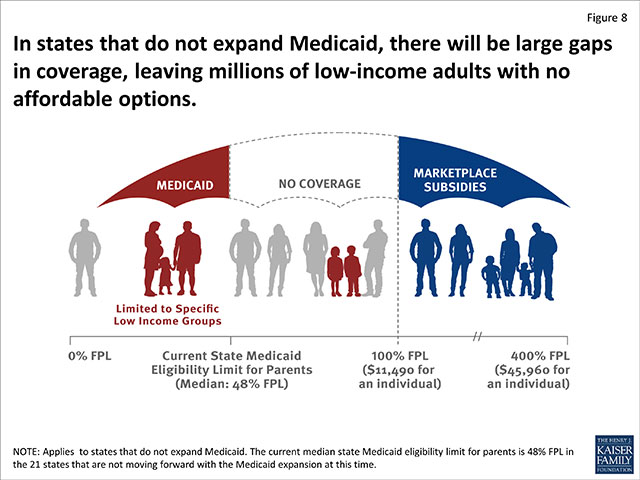ObamaCare Medicaid Expansion







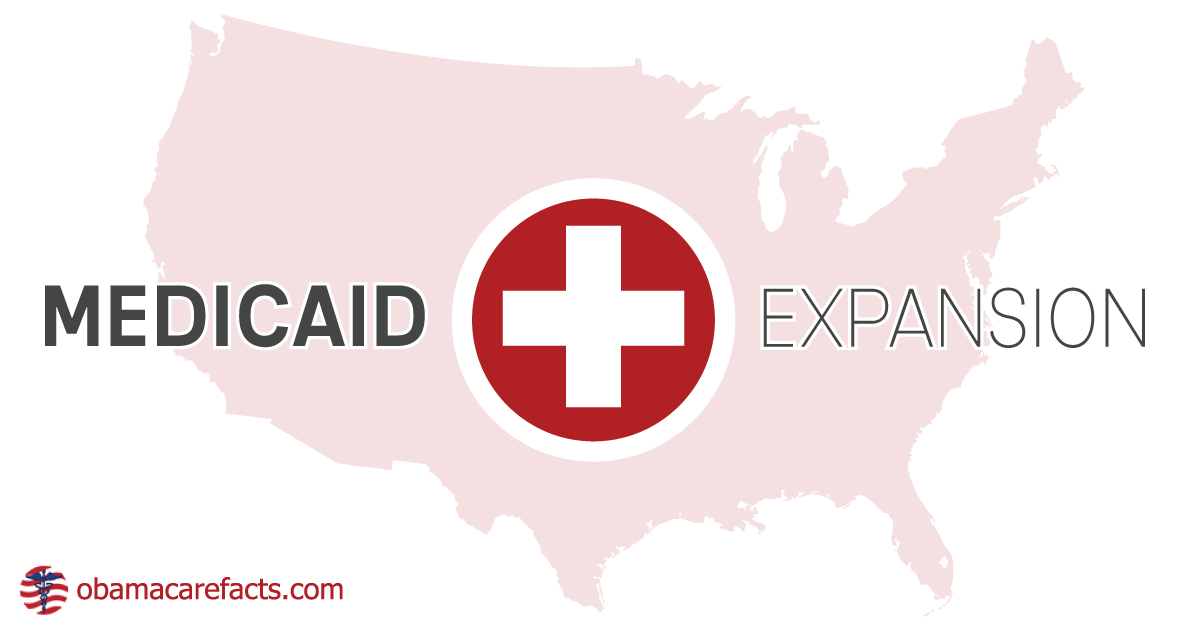
An Overview of Medicaid Expansion Under the Affordable Care Act (“ObamaCare”)
ObamaCare’s Medicaid Expansion is one of the biggest milestones in health care reform. ObamaCare’s Medicaid expansion expands Medicaid to our nation’s poorest in order to cover nearly half of uninsured Americans. However, a change to the law has left millions of working families without coverage.
ObamaCare’s Medicaid Expansion was originally projected to provide health insurance to over 20 million uninsured Americans in its first decade. However, many states initially opted out of Medicaid expansion leaving millions without health insurance options.
Today governors and state legislatures in 11 states still haven’t expanded or voted to expand Medicaid and millions of adults that should have been covered under ObamaCare aren’t. Luckily, many are.
So, why did some states opt out of expanding Medicaid? The short answer is politics and cost, the long answer is more complex.
Keep reading to find out how Medicaid expansion works, which states have expanded Medicaid, and why some states still haven’t expanded Medicaid under the Affordable Care Act.
TIP: Learn more about Medicaid and CHIP in your state by contacting your state Medicaid Department or Healthcare.gov. Some states have unique eligibility rules, so make sure to learn about all options available to you in your state.
Get Covered By Medicaid or CHIP Now
Medicaid and CHIP: You can sign up for Medicaid and CHIP 365 days a year. You may qualify for free or low-cost care for Medicaid based on income and family size if you make 138% of the poverty level. Specifics may differ by state.
If you think you are eligible for Medicaid, you can sign up for Medicaid now (you can even get coverage retroactively if you qualified but didn’t enroll in some cases).
If your state did not expand Medicaid and you have been denied Medicaid coverage, you are exempt from the mandate to obtain insurance and won’t owe the fee. If you apply for a hardship exemption for being denied Medicaid due to low income in a non-expansion state at HealthCare.Gov, you will likely qualify to shop for low-cost catastrophic coverage.
TIP: New states are expanding Medicaid each year, so make sure to check out the Current Status of State Medicaid Expansion Decisions. Also, CHIP is generally already expanded in most states, so even if adults don’t qualify families with young children and children themselves might.
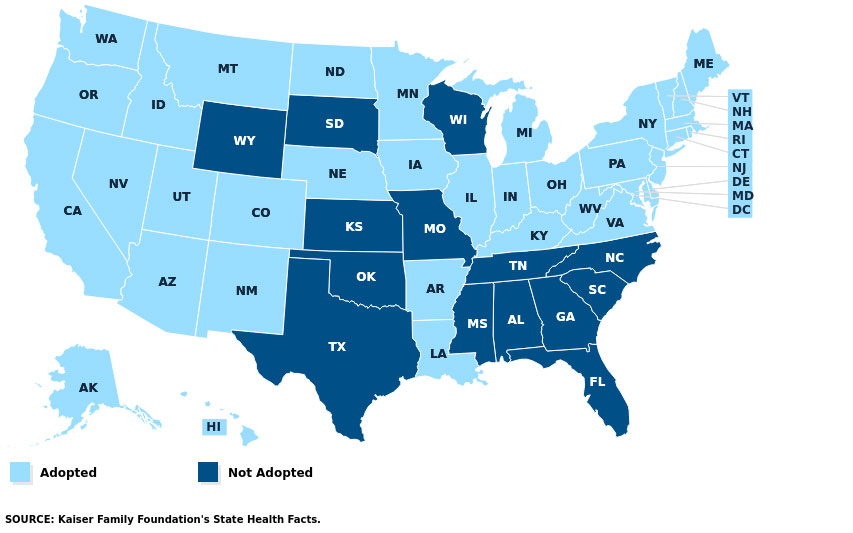
Map: Status of State Action on the Medicaid Expansion Decision. KFF.org. May, 2019. KS, MO, OK, and SD have all taken action since this map was created!
Medicaid Expansion Updates and Waivers
As of 2022, 39 states and the District of Columbia have expanded Medicaid or voted to expand Medicaid, while 11 states have not. Although the number gets lower with each new state that passes expansion, millions of adults who should have been covered under the ACA still lacked coverage as recently as 2020.
NOTE: Make sure to check the up-to-date list of states expanding Medicaid and an interactive map with descriptions of states considering expansion to see if your state is on there, we try to keep this page up to date, but details are subject to change.
Arizona, Arkansas, California, Colorado, Connecticut, Delaware, Washington D.C., Hawaii, Illinois, Iowa, Kentucky, Maryland, Massachusetts, Michigan, Minnesota, Nebraska, Nevada, New Hampshire, New Jersey, New Mexico, New York, North Dakota, Ohio, Oregon, Rhode Island, Vermont, Washington, and West Virginia started expanded Medicaid in 2014. Alaska, Indiana, and Pennsylvania expanded in 2015. Louisiana expanded in 2016. Montana also expanded in January 2016, but it will sunset on June 30, 2019 unless the state legislature acts to extend it. Maine adopted the Medicaid expansion through a ballot initiative in November 2017. Virginia expanded in 2018. Nebraska, Utah, and Idaho voters passed Medicaid expansion via ballot initiatives in November 2018. Then in 2019 even more states embraced Medicaid expansion like Montana. In 2020 Oklahoma and Missouri voted to expand Medicaid as well. In 2022 South Dakota voted to expand Medicaid.
Missouri and Wyoming had been seriously considering expansion in past years (Missouri ended up expanding, but Wyoming hasn’t as of 2022). Meanwhile, other states like Florida, which has 800,000 uninsured due to their current narrow Medicaid eligibility levels, are still discussing and debating expansion.
Most of these states enacted proposed Medicaid expansion alternatives that don’t always cover all adults or don’t cover them at the same cost sharing as other states, so know your state’s Medicaid program if they are on the above list.
If your state hasn’t expanded Medicaid yet, let your state representatives know that you deserve the same access to care that they have. Please note that specific facts and figures on this page are sometimes based on data from before these states expanded; the more states that expand, the fewer Americans go without coverage.
- See an up-to-date list of states expanding Medicaid and their status (including those not currently offering coverage, but with expansion in the works).
- See Recent Section 1115 Medicaid Demonstration Waivers (it’s what states file to opt-in to funding for expanding Medicaid).
FACT: A 2019 study found that states that expanded Medicaid under the Affordable Care Act (ObamaCare) saw a decrease in deaths compared to non-expansion states.
States Opting Out of Medicaid Expansion
The law previously required states to expand coverage to everyone making less than 138% of the Federal Poverty Level (FPL) or lose federal funding to Medicaid. However, that provision was changed during a supreme court ruling on ObamaCare.
States can now opt out of Medicaid Expansion, leaving millions of poor working families in the “Medicaid coverage gap” between those who qualify for Medicaid (as low as 50% FPL in some states) and those who qualify for marketplace subsidies (between 100% – 400% FPL).
States opting out of the expansion of Medicaid under ObamaCare will most likely both drive up insurance costs and not save the States much money. Some states, like Minnesota, showed up to a billion in new revenue under the program.
Join the ObamaCare Facts mailing list to keep up to date on the Medicaid Expansion vote in your state.
The bottom line on Medicaid Expansion: Does the money the states will save by not expanding Medicaid outweigh the costs related to millions going uninsured?
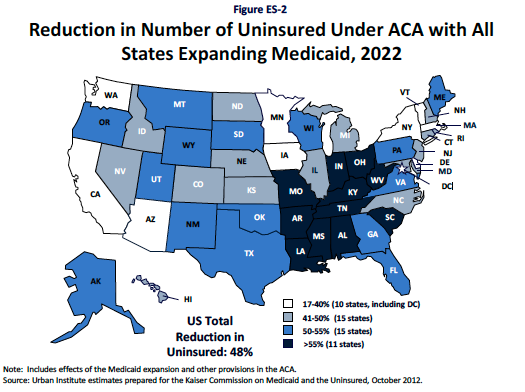 ObamaCare Medicaid Expansion Overview
ObamaCare Medicaid Expansion Overview
Let’s take a quick look at ObamaCare’s Medicaid expansion and how it affects American families.
• Medicaid is a joint federal and state-funded program that provides health care for over 60 million low-income Americans.
• As of 2013, every State had different eligibility requirements for Medicaid based on income, age, gender, the number of dependents, and other specific requirements.
• Some states had or have very narrow eligibility requirements for Medicaid, which leave many working adults uninsured.
• Starting in 2014 states that participated in Medicaid expansion increased eligibility levels for everyone in their state to 138% of the Federal Poverty Level.
• Even if your state didn’t expand Medicaid, you may be eligible for Marketplace subsidies if you make between 100% – 400% FPL.
• States that did not expand have unique eligibility requirements.
• Before expansion, many states covered those who had no income, given this expansion often extended coverage to the working poor and their families. As of April 2015, most of the states who have not expanded Medicaid have 0% eligibility for childless adults, but all states offer CHIP to parents with no income. See CHIP and Medicaid eligibility in non-expansion states.
• Poor working families are the most likely to not have insurance due to affordability. Medicaid expansion helps “cover the gap” between current Medicaid eligibility and families being able to afford private health insurance using marketplace subsidies.
• During open enrollment, you can sign up for Medicaid through your state’s health insurance marketplace.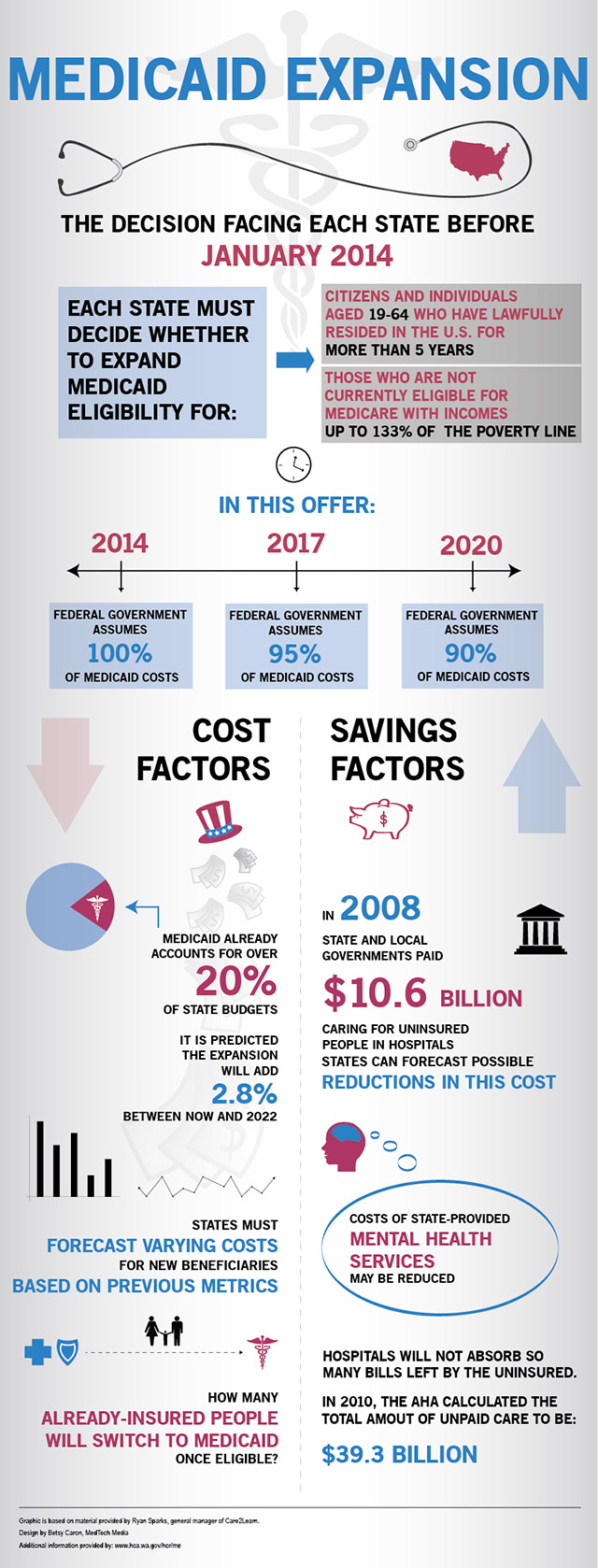
• About half of the uninsured in America would be covered by Medicaid Expansion if all states opted in and joined the program.
• More than 15 million men, women, and children will be eligible for Medicaid in states that participate in Medicaid Expansion.
• Because 24 States have not expanded Medicaid, 5.7 million people will be uninsured in 2016.
• Only 54% of potentially eligible adults are aware of Medicaid expansion under the Affordable Care Act.
• Millions of Americans will be able to get care before they are forced to use costly, last-minute emergency services.
• The uninsured currently cost hospitals billions in unpaid hospital bills – some of these costs are indirectly passed onto the average taxpayer with insurance.
• One of the leading causes of rising premium costs is unpaid hospital bills.
• The Federal Government pays 100% of expansion costs for the first three years and 90% after that until 2022.
• Many state’s budgets have shown that expanding Medicaid raised money for the State.
• Cost is the most cited reason for not expanding Medicaid. While current Medicaid programs do cost state taxpayers a lot of money, that spending is balanced by unpaid hospital bills and the effect those bills have on the rising costs of premiums.
• Most states that opted out of expansion, Vermont and Montana aside, had a Republican governor when Medicaid expansion was originally rejected.
• In general, the states who opted out have the highest uninsured rates and would be the states which expansion would help the most.
• Of course, the higher number of uninsured who qualify for Medicaid, the more it costs the state to cover them.
• Some people say that opting out of Medicaid expansion is part of an ongoing effort to “break” ObamaCare regardless of the cost to the people. Other tactics include opting out of creating exchanges, funding expensive disinformation campaigns, threatening or causing a Government shutdown, suing the President, and attempting to repeal the law (50+ times).
• States had until January 2014 to decide if they would expand Medicaid. Many states are not moving forward with the program at this time. However, they can still decide to expand Medicaid later. For instance, PA decided to expand Medicaid in 2014. TE and IN are expanding as of 2015.
• States expanding Medicaid – AK, AZ, AR, CA, CO, DE, DC, HI, IL, IA, IN, KY, MD, MA, MN, MA, NH, NV, NJ, UT, NM, NY, ND, OH, OR, PA, RI, VT, VA, WA, WV. States not expanding Medicaid at this time – AL, FL, GA, ID, KS, LA, ME, MS, NE, NC, OK, SC, SD, TX, WI. States considering expanding Medicaid – MO, MT, TN, WY (see full list above, remember this is all subject to change)
Know the Law. The Affordable Care Act contains 10 titles. Each title addresses a different aspect of health care reform. Title II – The Role of Public Programs addresses Medicaid expansion. Check out our Summary of Provisions of the Patient Protection and Affordable Care Act for a plain English summary of each provision pertaining to the Affordable Care Act and Medicaid expansion.
History of ObamaCare’s Medicaid Expansion and the NFIB
When the NFIB took the Affordable Care Act to the Supreme Court in an attempt to repeal it, the Medicaid expansion requirement was overturned leaving millions without access to health insurance.
Since the ruling, each state has been able to decide whether or not they want to opt-out of expanding coverage to 138% of the federal poverty level without facing penalties in reduced federal funding. This has resulted in many states opting out of expansion and keeping their narrow eligibility guidelines.
The new ruling doesn’t just hurt Medicaid and ObamaCare; it affects the tax-payer by forcing us to pay for states that choose not to help their poorest. Even though expanding Medicaid would have cost the federal tax-payer, states and tax-payers are still picking up the tab on those who fall into the “Medicaid gap” because these individuals will either use emergency services or purchase subsidized health insurance through the marketplace using federal tax credits. In other words, while it potentially saves the state money, it leaves millions without insurance and still shifts costs to federal tax-payers.
• National Federation of Independent Business (NFIB) is an “independent” group that represents “small business.” However, they historically follow the Republican party line and fight against “entitlement” programs like ObamaCare’s Medicaid Expansion, which help the nation’s poorest working families and smaller businesses.
• About half of the uninsured are small business owners and employees. Many of these uninsured Americans would have qualified for coverage under Medicaid expansion had the NFIB not taken the ACA to court.
• Remember that the only businesses that pay more under ObamaCare are the top 3% of small businesses and big businesses. Learn more about small business and ObamaCare.
Nearly ONE HALF of uninsured Americans were going to get their health insurance under ObamaCare Medicaid reform by expanding coverage to the nation’s poorest starting in 2014. Now states can opt-out without losing federal funding.
What is Medicaid?
Medicaid is a joint federal and state-funded program that provides health care for over 60 million low-income Americans–primarily children, pregnant women, people with disabilities, and senior citizens who need help or live in nursing homes.
Since Medicaid is a program that works partly on a state level with help from the federal government, the rules alter from state to state. The general rule of thumb is that most low-income adults under 65 cannot currently receive Medicaid.
What is CHIP Children’s Health Insurance Program?
Medicaid works closely with the Children’s Health Insurance Program (CHIP). Learn more about ObamaCare and the Children’s Health Insurance Program (CHIP) and see if your child qualifies.
How is Medicaid Funded?
Medicaid is jointly funded by the federal government and the states. The federal government pays states for a specified percentage of program expenditures, called the Federal Medical Assistance Percentage (FMAP). FMAP varies by state based on criteria such as per-capita income. Under the Affordable Care Act, states that choose to expand get 90% of their expansion costs funded by the federal government helping to ensure states aren’t overburdened by the cost. However, some states that opted out felt that they couldn’t depend on the federal government to continue paying this percentage and that costs would be too high even with the federal funding.
This video explains how Medicaid is funded and how the ACA affects Medicaid funding.Who Qualifies for Medicaid?
Medicaid works differently in every State. The Federal Government used to set the eligibility guidelines for Medicaid, and some states chose to expand the guidelines. This is how it worked before ObamaCare, and due to the Medicaid expansion opt-out, it still works this way today.
• To be eligible for coverage, a person must belong to an eligible group (generally: children, pregnant women, parents, blind or disabled persons, and the elderly) and meet the financial eligibility requirements for that group.
• Before the ACA, the federal government had mandated that eligibility levels for children and pregnant women be at least 100-133 percent (see table below), but eligibility levels for parents could be much lower, and states were not required to cover adults without dependent children at all.
• As of December 2009, eligibility levels for parents in 17 states were at or below 50 percent FPL (which is $11,725 for a family of four in 2012). Another 17 states set eligibility levels for parents at or below 100 percent FPL (which is $23,550 for a family of four in 2013).
• As of December 2009, only five states allowed adults without dependent children to enroll in Medicaid, although two of those states plus another 14 states offered some limited set of benefits to some childless adults.
• The eligibility requirements of Medicaid leave about 20 million people in the gap between being able to afford insurance and being eligible for Medicaid.
• Children who don’t qualify for Medicaid may qualify for CHIP (Children’s Health Insurance Program), which works closely with Medicaid.
• Medicaid can also help seniors. If you qualify for Medicaid in your state, you automatically qualify for extra help paying your Medicare prescription drug coverage (Part D). Medicaid also offers benefits not normally covered by Medicare, like nursing home care and personal care services.
You can find out if you qualify for Medicaid or CHIP on healthcare.gov.
What is Medicaid Expansion?
Medicaid expansion expands Medicaid eligibility to all individuals and families earning below 138% of the Federal Poverty Level. This includes many groups (like single men) who weren’t previously eligible.
Medicaid Expansion Guidelines
The following guidelines will help you find out if you qualify for Medicaid (if you make under 138% of the poverty level in expansion states, you qualify; otherwise see other assistance levels).
These guidelines only apply to states who expanded Medicaid. See additional guidelines below for eligibility levels that apply to states that did not expand Medicaid.
TIP: For mobile and smaller screen sizes, drag the table below to scroll and see the different poverty levels.
| 2020 POVERTY GUIDELINES FOR THE 48 CONTIGUOUS STATES AND THE DISTRICT OF COLUMBIA | ||||
|---|---|---|---|---|
| Persons in Family/Household | 100% FPL: Minimum to Qualify for ACA Assistance | 138% FPL: Medicaid Cap (in States that Expanded) | 250% FPL: CSR Subsidies Cap | 400% FPL: Premium Tax Credit Cap |
| 1 | $12,760 | $17,609 | $31,900 | $51,040 |
| 2 | $17,240 | $23,792 | $43,100 | $68,960 |
| 3 | $21,720 | $29,974 | $54,300 | $86,880 |
| 4 | $26,200 | $36,156 | $65,500 | $104,800 |
| 5 | $30,680 | $42,339 | $76,700 | $122,720 |
| 6 | $35,160 | $48,521 | $87,900 | $140,640 |
| 7 | $39,640 | $54,704 | $99,100 | $158,560 |
| 8 | $44,120 | $60,886 | $110,300 | $176,480 |
| For families/households with more than 8 persons, add $4,480 for each additional person. | ||||
NOTE: Alaska and Hawaii use different guidelines (see this link to guidelines as published on HHS.Gov).
Who Qualifies for Medicaid Expansion Under ObamaCare?
Eligibility for Medicaid expansion is decided by the state. In states that do expand Medicaid, all legal residents who earn less than $15,302 for individuals and $31,155 for families of four can receive Medicaid under Medicaid Expansion. In States that don’t expand Medicaid, eligibility includes only a very limited cross-section of the population and may have income caps as low as 50% FPL. People covered under the expansion also include:
• Low-income adults (with or without dependent children).
• Low-income children who lose their Medicaid benefits when they are reclassified as adults 19 years.
• Low-income adults with disabilities who are not eligible for SSID or SSI.
The following table is an example of eligibility levels for different groups by % of the Federal Poverty Level (FPL)
| Categorical group | U.S. minimum threshold pre-ACA, 2009* | State thresholds, 2009: medians, (ranges) | U.S. minimum thresholds under ACA, 2014 and beyond** |
| Children 0-5 | 133% FPL | 235% FPL (133-300% FPL ) |
133% FPL |
| Children 6-19 | 100% FPL | 235% FPL (100-300% FPL) |
133% FPL (note traditional vs new) |
| Pregnant women | 133% FPL | 185% FPL (133-300% FPL) |
133% FPL |
| Working parents | State’s July 1996 AFDC eligibility level^ | 64% FPL (17-200% FPL) |
133% FPL (note traditional vs new) |
| Non-working parents | State’s July 1996 AFDC eligibility level^ | 38% FPL (11-200% FPL) |
133% FPL (note traditional vs new) |
| Childless adults | Eligibility not mandated. State must apply for waiver to cover this group. | 0% FPL (0% FPL in 46 states; 100-160% FPL in 5 states) |
133% FPL (note traditional vs new |
| Elderly, blind, disabled | Receipt of SSI^ | 75% FPL (65-133% FPL) |
Receipt of SSI |
Has Expanding Medicaid Worked Before?
New York, Arizona, and Maine expanded Medicaid between 2000 and 2005. A Harvard study reports, “rates of uninsured residents dropped, access to care improved, and more people reported being in very good or excellent health.” The coverage was estimated to save a total of 2,840 lives each year in these states.
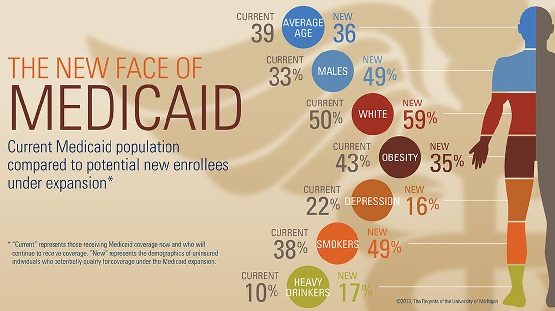
Why the ObamaCare Medicaid Expansion Matters
Medicaid expansion would provide access to health insurance for almost half of our nation’s uninsured.
Letting states opt out of ObamaCare’s Medicaid expansion not only leaves millions without coverage, but it also costs taxpayers money.
Uninsured Americans cost taxpayers money because they use costly emergency services instead of getting the preventative care they need.
In states that don’t set up a marketplace or expand Medicaid, federal tax dollars are used to subsidize many who would have been eligible for Medicaid under expansion. Medicaid costs are shared between the State and Federal Governments.
Medicaid Expansion 133% or 138%?
Sometimes we say Medicaid is expanded to 133% FPL, and sometimes we say 138%. Both are correct. The text of the ACA says 133%, but the law also calls for a new methodology of calculating income, which will make the effective minimum threshold of 138%. Either way, remember that these are minimum thresholds; states can set eligibility thresholds higher, and many already have for certain populations, which means that more people qualify.
Selected federal poverty level (FPL) thresholds regarding annual income, 2014. Please note that ObamaCare uses the 2014 Federal Poverty Guidelines for 2015. Please also note the chart below is meant for educational purposes, for assistance in the current year see our federal poverty level page.
| FPL | Individual | Family of four | Relevance |
| 50% | $5,835 | $11,925 | Currently (prior to the ACA Medicaid expansion), parents in 17 states don’t qualify for Medicaid unless their incomes are below this threshold. (Eligibility levels for children are higher, so in a given family, children may qualify while parents don’t.) In nearly all states, childless adults are ineligible regardless of income. |
| 100% | $11,670 | $23,850 |
This is the official poverty threshold, updated each year by the federal government. It varies by family size and composition. As written in the ACA, persons with family incomes below this threshold are not eligible for subsidies to purchase insurance in the exchanges. In states that don’t expand Medicaid, individuals with incomes above their state’s current eligibility level, but below 100 percent FPL, will not qualify for anything. |
| 133% | $14,856 | $30,675 | As written in the ACA, this will be the new minimum eligibility threshold for nearly everyone under 65. However, the effective threshold will actually be 138%. See next line. |
| 138% | $16,105 | $32,913 | Even though the ACA states that the new threshold is 133%, it will effectively be 138%, because 5% of people’s income will be “disregarded.” See below for more information. |
| 400% | $46,680 | $95,400 | This will be the upper limit for eligibility for income-based subsidies for the purchase of private insurance through the new health insurance exchanges. |
How to Apply for Medicaid
In the past, applying for Medicaid meant you needed to meet certain criteria – for example, being pregnant, having a child, or having a disability – in addition to meeting an income requirement. In states that have implemented expansion the only requirement is that you make less than 133% of the Federal poverty level.
Since the guidelines are so complicated, the easiest way to find out if you are eligible for Medicaid is to fill out an application at your state’s health insurance marketplace. Read our guide to the Health Insurance Exchanges to find out more about using your State’s online marketplace to sign up for insurance. The application process will notify you if you are eligible for Medicaid.
Sign Up for Medicaid Now
Each state has different rules regarding eligibility and the application process for Medicaid. You can use one of the two following methods to apply for Medicaid:
1. Visit your State’s Health Insurance Marketplace by finding it on our list.
2. Call your state Medicaid program to see if you qualify and learn how to apply.
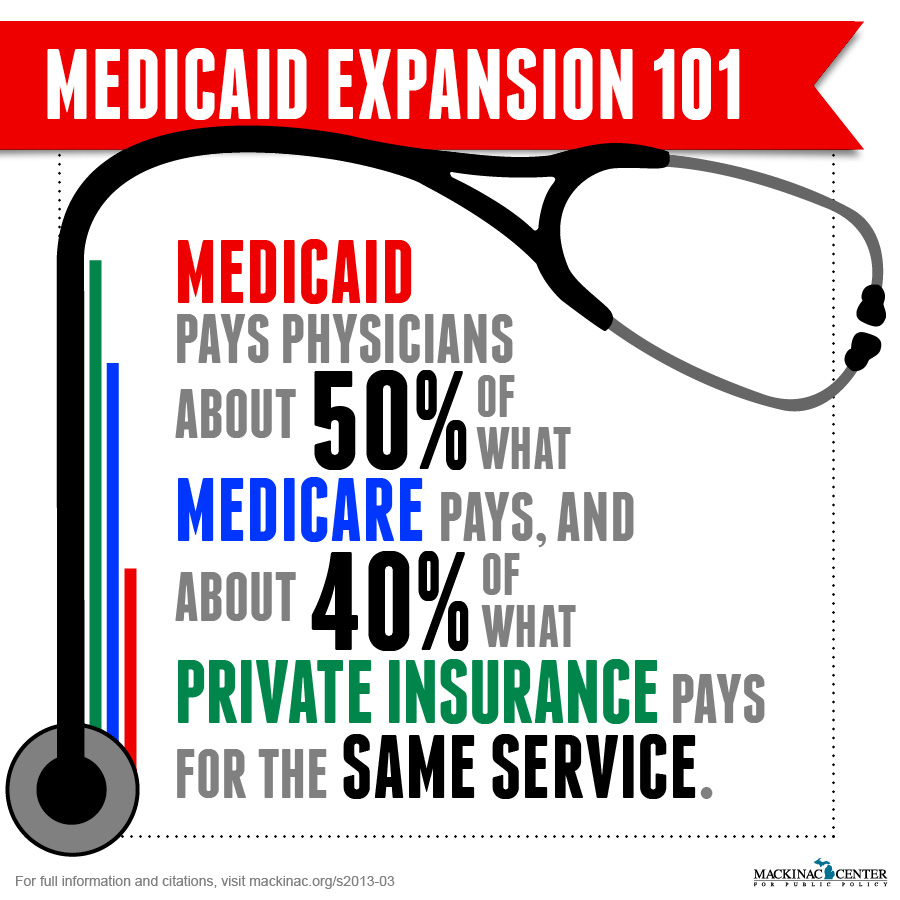 What is “Wrong” With Medicaid?
What is “Wrong” With Medicaid?
ObamaCare opponents use the downfalls of Medicaid as terms to reject Medicaid Expansion. Drawbacks of Medicaid include limited access to health care, low-end quality health care and coverage, and low doctor payouts. ObamaCare’s reforms address many of the issues with the quality of Medicaid by increasing the quality of care for all types of insurance. The ACA also contains provisions to increase doctor payouts as well.
Historically, Medicaid doctor payouts have been low. Due to small payouts, many doctors don’t take Medicaid patients, and the quality of care Medicaid patients do get tends to below. However, ObamaCare’s Medicaid Reforms do a lot to change this.
The ObamaCare Medicaid reforms that come with ObamaCare’s Medicaid Expansion include raising the amount doctors get paid to the same level of Medicare (73%) and increasing payments to Medicaid programs that offer preventive services for free or at little cost. New free preventive services include tests for high blood pressure, diabetes, and high cholesterol; many cancer screenings, including colonoscopies and mammograms; counseling to help people lose weight, quit smoking or reduce alcohol use; routine vaccinations; flu and pneumonia shots; and other services.
ObamaCare Medicare Reforms
Aside from Medicaid expansion itself, the Affordable Care Act does a lot to improve Medicaid. You can check out the complete list of reforms here.
ObamaCare Medicaid Expansion Opt-Out: The Medicaid Gap
Since states have the right to opt-out of expanding Medicaid without losing any federal funding, many potentially eligible Americans are left in “the Medicaid gap.” The gap refers to those who don’t qualify for Medicaid and don’t make enough to qualify for Marketplace Subsidies either.
ObamaCare Medicaid reform was meant to cover over 20 million Americans through Medicaid. Now up to 5.7 million are estimated to go without health insurance solely due to states rejecting expansion.
Expansion Fact: Texas opting out of Medicaid Expansion leaves 1.1 million Texans with no coverage due to the Medicaid coverage gap.
What if All States Moved Forward With Medicaid Expansion?
If all states move forward with ObamaCare’s Medicaid Expansion, they would collectively pay $76 billion (a 3% increase) to insure up to 21.3 Million individuals who don’t have access to health insurance (about half of the entire nation’s uninsured) over the next decade. Obviously, those who have more to cover will have to spend more. Regardless of what a state spends, the Federal Government covers 93% of the State’s costs. State spending increases are relatively small compared to both the amount the states would pay without ObamaCare and the 26% increase that the federal government will pay towards Medicaid.
More ObamaCare Medicaid Expansion Facts
Here are some detailed facts on Medicaid expansion:
• The federal government will pay a very high share of new Medicaid costs in all states. 100% of costs are covered for the first year. 90% of the spending is done by federal government moving forward.
•Increases in state spending are small both compared to increases in coverage and federal revenues and about what states would have spent if reform had not been enacted.
• ObamaCare Medicaid Expansion sets the eligibility level for Medicaid at 133% FLP, but there is a special deduction to income equal to five percentage points of the poverty level. This raises the effective eligibility level to 138% of poverty.
• The legislation maintains existing income counting rules for the elderly and groups eligible for another program like foster care, low-income Medicare beneficiaries, and Supplemental Security Income (SSI).
• The NFIB helped to change the Affordable Care Act to include a “state opt-out” for Medicaid Expansion.
• the NFIB received $50,0000 of indirect Koch money via Free Enterprise America.
• In combination with ObamaCare’s other provisions, if all states participated in Medicaid expansion, it would reduce the number of uninsured by 48% (about the number of uninsured without the ObamaCare). States with higher uninsured rates before ObamaCare would see larger increases in Medicaid and bigger reductions in the uninsured (compared to states with lower pre-ObamaCare uninsured rates).
• If all states implement the expansion, an additional 21.3 million individuals could gain Medicaid coverage by 2022 – a 41% increase compared to Medicaid without ObamaCare. With many States opting out, the number is expected to fall below 15 million.
• Medicaid Expansion covers those who are most likely to use emergency services that cost hospitals tens of billions in unpaid hospital bills.
• States will spend little to nothing expanding Medicaid. For example, it would cost the State of Florida about $5 each year per person to cover all uninsured below the 138% FPL.
• Low-income families and other Americans who would be eligible for Medicaid will fall between the cracks without expansion (as they do now). ObamaCare will most likely have to insure them in the ObamaCare health exchanges. This is projected to drive up the cost of insurance for all Americans by a significant amount.
•Big Business-backed groups like ALEC and the NFIB frequently suggest legislation that seeks to dismantle public programs at a state level. They tend to achieve this in Red states where they have the most pull. These states need Medicaid the most as they have the most low-income individuals falling through the cracks. They will also put a bigger burden on everyone else as it will cost more to insure their poorest on the marketplaces.
• If Medicaid Expansion is opted-out of by too many states, it will diminish the effectiveness and affordability of ObamaCare. Stop your state from opting out of Medicaid by helping to share the ObamaCare Facts.
• The federal government paid for most (90% – 100%) of the Medicaid expansion when it was implemented in 2014, but states will be required to pay for up to 10% percent of it by 2020.
• Some states are saying that paying 0% – 10% of the Medicaid expansion (as laid out under ObamaCare) will cost them too much. While some states will pay more, the increase is very small (3% average increase in Medicaid Spending) even for the States who will pay the most. Keep in mind that emergency room visits cost the State tax-payer millions, while the burden of Medicaid is split between the Federal Government and the State. Therefore most states would save money over the first 3 years of expansion if not sooner.
• A Harvard case study found that states who had expanded their Medicaid programs from 2000 to 2005 improved health care for the state and saved thousands of lives.
• Some states are expected to save Billions from ObamaCare’s Medicaid Expansion.
Who Rejected Medicaid Expansion?
Many of the states that rejected Medicaid Expansion are those who need it the most. Uninsured rates tend to be higher in “red states.” In Texas, for example, 25% of the population is uninsured. Texas opted out of Medicaid Expansion and chose not to create a health insurance marketplace.
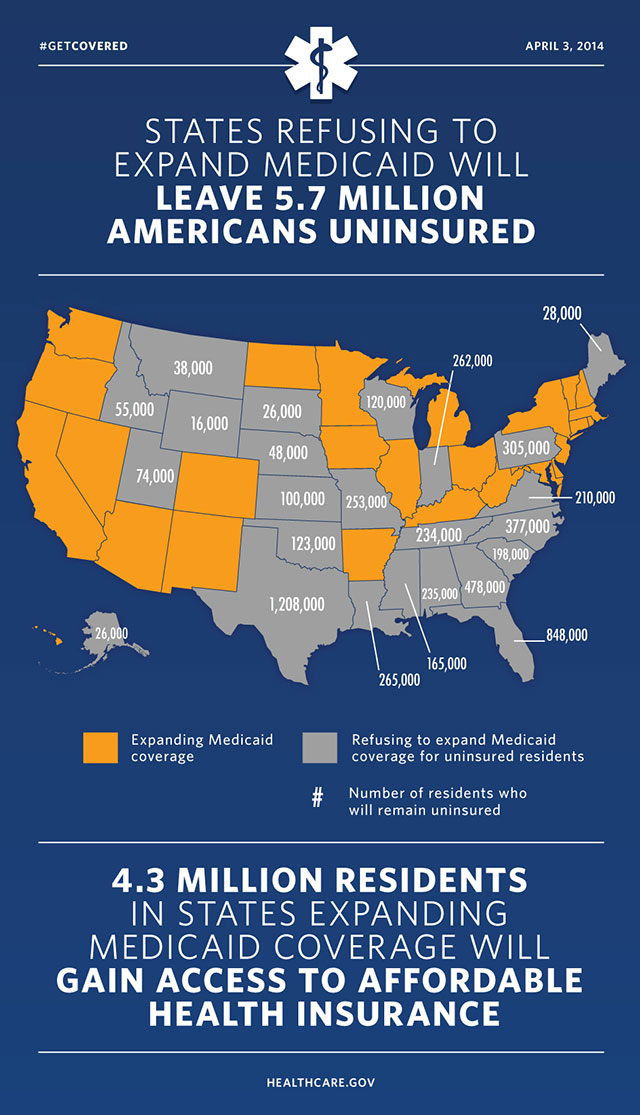
Which States Expanded Medicaid under Medicaid Expansion?
Want to know which states will insure the 15 million Americans below the poverty line and which states will leave the rest of the 21.3 million uninsured behind? Find out which states support their poorest. Want more information on ObamaCare and Medicaid Expansion? Get the Full KFF Medicaid Expansion Report.
This list is kept up to date, but states can still choose to expand Medicaid. Even if you are not eligible for Medicaid, you may be able to get very low-cost health insurance through your state’s health insurance marketplace through cost assistance subsidies.
Get a current update on where the states are at now and who has been covered by Health and Human Services HHS.
Update: PA initially rejected but decided to move forward with expansion in August of 2014. Expansion (Healthy PA Private Coverage Option) should begin in PA as soon as December 2015. Pennsylvania proved that we can still hope to see expansion in more states. Please note that other states have started moving forward with expansion. We will continue to update this list as they officially start expanding Medicaid.
Some other states have filed waivers or have created plans to expand since initial rejections of Medicaid.
States Expanding Medicaid as of March 6, 2015 (see additional states for 2020 and beyond in the links above)
| Location | Current Status of Medicaid Expansion Decision |
|---|---|
| United States | Adopted the Medicaid Expansion: 29 states (including DC); Adoption of the Medicaid Expansion Under Discussion: 6 states; Not Adopting the Medicaid Expansion at this Time: 16 states |
| Alabama | Not Adopting the Medicaid Expansion at this Time |
| Alaska | Adoption of the Medicaid Expansion Under Discussion1 |
| Arizona | Adopted the Medicaid Expansion |
| Arkansas | Adopted the Medicaid Expansion2 |
| California | Adopted the Medicaid Expansion |
| Colorado | Adopted the Medicaid Expansion |
| Connecticut | Adopted the Medicaid Expansion |
| Delaware | Adopted the Medicaid Expansion |
| District of Columbia | Adopted the Medicaid Expansion |
| Florida | Adoption of the Medicaid Expansion Under Discussion3 |
| Georgia | Not Adopting the Medicaid Expansion at this Time |
| Hawaii | Adopted the Medicaid Expansion |
| Idaho | Not Adopting the Medicaid Expansion at this Time |
| Illinois | Adopted the Medicaid Expansion |
| Indiana | Adopted the Medicaid Expansion2, 4 |
| Iowa | Adopted the Medicaid Expansion2 |
| Kansas | Not Adopting the Medicaid Expansion at this Time |
| Kentucky | Adopted the Medicaid Expansion |
| Louisiana | Not Adopting the Medicaid Expansion at this Time |
| Maine | Not Adopting the Medicaid Expansion at this Time |
| Maryland | Adopted the Medicaid Expansion |
| Massachusetts | Adopted the Medicaid Expansion |
| Michigan | Adopted the Medicaid Expansion2, 4 |
| Minnesota | Adopted the Medicaid Expansion |
| Mississippi | Not Adopting the Medicaid Expansion at this Time |
| Missouri | Adoption of the Medicaid Expansion Under Discussion5 |
| Montana | Adoption of the Medicaid Expansion Under Discussion6 |
| Nebraska | Not Adopting the Medicaid Expansion at this Time |
| Nevada | Adopted the Medicaid Expansion |
| New Hampshire | Adopted the Medicaid Expansion2, 4 |
| New Jersey | Adopted the Medicaid Expansion |
| New Mexico | Adopted the Medicaid Expansion |
| New York | Adopted the Medicaid Expansion |
| North Carolina | Not Adopting the Medicaid Expansion at this Time |
| North Dakota | Adopted the Medicaid Expansion |
| Ohio | Adopted the Medicaid Expansion |
| Oklahoma | Not Adopting the Medicaid Expansion at this Time |
| Oregon | Adopted the Medicaid Expansion |
| Pennsylvania | Adopted the Medicaid Expansion2, 4 |
| Rhode Island | Adopted the Medicaid Expansion |
| South Carolina | Not Adopting the Medicaid Expansion at this Time |
| South Dakota | Not Adopting the Medicaid Expansion at this Time |
| Tennessee | Adoption of the Medicaid Expansion Under Discussion7 |
| Texas | Not Adopting the Medicaid Expansion at this Time |
| Utah | Adoption of the Medicaid Expansion Under Discussion8 |
| Vermont | Adopted the Medicaid Expansion |
| Virginia | Not Adopting the Medicaid Expansion at this Time |
| Washington | Adopted the Medicaid Expansion |
| West Virginia | Adopted the Medicaid Expansion |
| Wisconsin | Not Adopting the Medicaid Expansion at this Time9 |
| Wyoming | Not Adopting the Medicaid Expansion at this Time |
Footnotes
- Alaska’s Governor Bill Walker, who took office on December 1, 2014, has announced the implementation of the Medicaid expansion as a top priority for his administration.
- Arkansas, Indiana, Iowa, Michigan, New Hampshire and Pennsylvania have approved Section 1115 waivers for the Medicaid expansion. Coverage under the Pennsylvania waiver went into effect on 1/1/15, but the newly-elected governor has stated he will transition coverage to a state plan amendment.
- The Governor has expressed support for the Medicaid expansion in the past, and the legislature is actively considering expansion.
- Coverage under the Medicaid expansion became effective January 1, 2014, in all states that have adopted the Medicaid expansion except for the following: Michigan (4/1/2014), New Hampshire (8/15/2014), Pennsylvania (1/1/2015) and Indiana (2/1/2015).
- Missouri’s Governor Nixon has included the Medicaid expansion as part of his FY 2016 executive budget proposal.
- Montana’s Governor Steve Bullock has included the Medicaid expansion as part of his FY 2016 executive budget proposal.
- Tennessee’s Governor Bill Haslam published an alternative Medicaid expansion proposal in December 2014 called the Insure Tennessee plan.
- Utah’s Governor Gary Herbert has put forward an alternative Medicaid expansion proposal called the Healthy Utah plan; there has been no formal submission to CMS at this time, though the Governor has been in discussion with CMS about his proposal.
- Wisconsin covered adults up to 100% FPL in Medicaid but did not adopt the ACA expansion.
A pre-2015 including the names of the Governors who rejected Expansion
NOT PARTICIPATING (24 states)
- Alabama*: Gov. Robert Bentley (R)
- Alaska*: Gov. Sean Parnell (R)
- Florida*: Gov. Rick Scott (R)
- Georgia*: Gov. Nathan Deal (R)
- Idaho*: Gov. C.L. Otter (R)
- Indiana: Gov. Mike Pence (R)
- Kansas: Gov. Sam Brownback (R)
- Louisiana*: Gov. Bobby Jindal (R)
- Maine*: Gov. Paul LePage (R)
- Mississippi*: Gov. Phil Bryant (R) – Currently Steve Bullock (D) who supports expansion, although it hasn’t been enacted by the state.
- Montana: (R)
- Nebraska*: Gov. Dave Heineman (R)
- North Carolina: Gov. Pat McCrory (R)
- Oklahoma: Gov. Mary Fallin (R)
- Pennsylvania*: Gov. Tom Corbett (R) UPDATE: Congratulations Pennsylvania for agreeing to expand Medicaid under Pennsylvania’s “Healthy PA” program. Once the program is in action, we will take their name off of the list.
- South Carolina*: Gov. Nikki Haley (R)
- South Dakota: Gov. Dennis Daugaard (R)
- Tennessee: Gov. Bill Haslam (R)
- Texas*: Gov. Rick Perry (R)
- Utah: Gov. Gary Herbert (R)
- Vermont: Gov. Peter Shumlin (D)
- Virginia: Gov. Bob McDonnell (R)
- Wisconsin*: Gov. Scott Walker (R)
- Wyoming*: Gov. Matt Mead (R)
PARTICIPATING (26 states and the District of Columbia)
- Arizona*: Gov. Jan Brewer (R)
- Arkansas: Gov. Mike Beebe (D)
- California: Gov. Jerry Brown (D)
- Colorado*: Gov. John Hickenlooper (D)
- Connecticut: Gov. Dannel Malloy (D)
- Delaware: Gov. Jack Markell (D)
- District of Columbia: D.C. Mayor Vincent Gray (D)
- Hawaii: Gov. Neil Abercrombie (D)
- Illinois: Gov. Pat Quinn (D)
- Iowa*: Gov. Terry Branstad (R)
- Kentucky: Gov. Steve Beshear (D)
- Maryland: Gov. Martin O’Malley (D
- Massachusetts: Gov. Deval Patrick (D)
- Michigan*: Gov. Rick Snyder (R)
- Minnesota: Gov. Mark Dayton (D)
- Missouri: Gov. Jay Nixon (D)
- Montana: Gov.-elect Steve Bullock (D)
- Nevada*: Gov. Brian Sandoval (R)
- New Jersey: Gov. Chris Christie (R)
- New Hampshire: Gov. Maggie Hassan (D)
- New York: Gov. Andrew Cuomo (D)
- New Mexico: Gov. Susana Martinez (R)
- North Dakota*: Gov. Jack Dalrymple (R)
- Ohio*: Gov. John Kasich (R)
- Oregon: Gov. John Kitzhaber (D)
- Rhode Island: Gov. Lincoln Chaffee (I)
* indicates a state’s participation in the multi-state lawsuit against ACA
Go Here For Governor’s Statements on the Medicaid Expansion.
The Cost Of Medicaid Expansion
While states like Florida and Colorado say that a 3% increase in spending is too much, states like Michigan are showing that the states can save money by adopting the Medicaid expansion.
The nonprofit Center for Healthcare Research & Transformation projected the net costs of Michigan expanding Medicaid under the health system reform law. In all three scenarios of enrollment uptake assumed by the researchers, the state would reduce both overall spending and the numbers of uninsured residents. Figures represent the state’s 10-year cost savings, in millions, under moderate projections for the enrollment of newly Medicaid-eligible residents in 2014 (the expansion’s first year).
$1,861 million: Reduction in non-Medicaid mental health spending
$504 million: Reduction in prisoner inpatient medical spending
$444 million: Increase in tax revenues from health facilities and professionals
$395 million: Savings from elimination of Adult Benefit Waiver program
$23 million: Reduction in state employee health spending
$3,228 million: Total state budget savings
$2,245 million: Gross state expansion costs
$983 million: Net state budget savings
Note: Savings amounts do not add up to total savings due to rounding.
Protect The Expansion of Medicaid at a State Level
If it moves forward in all 50 states, ObamaCare’s Medicaid expansion will help half of the nation’s uninsured get access to health care. If we don’t support Medicaid Expansion on a state level, our nation’s poorest will go without healthcare. Although many states have already decided to opt-out of Expansion, it’s not too late to show your support. If you believe in health care reform, support Obamacare’s Medicaid Expansion in your state.
The Facts on ObamaCare’s Medicaid Expansion
![]()
